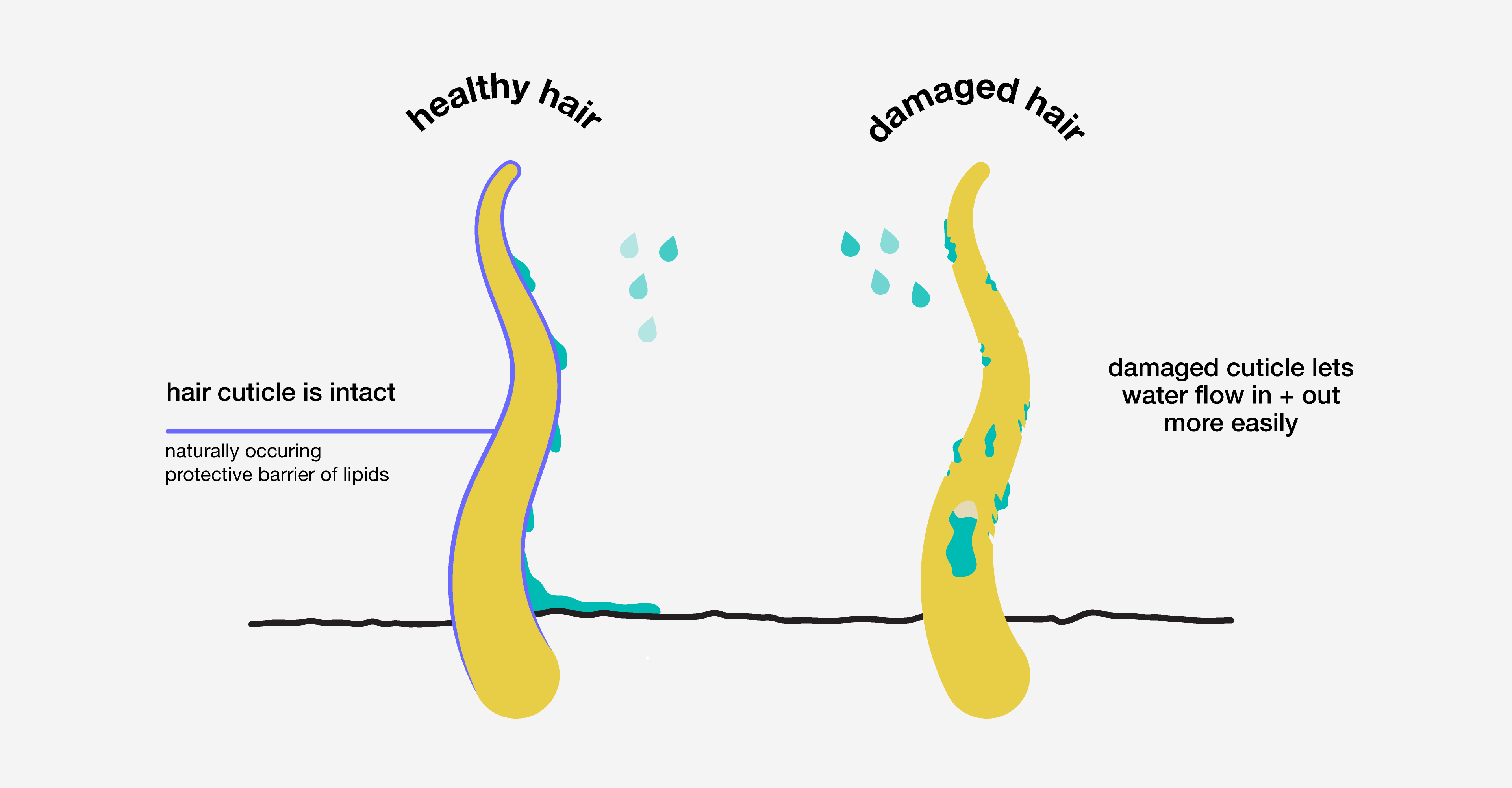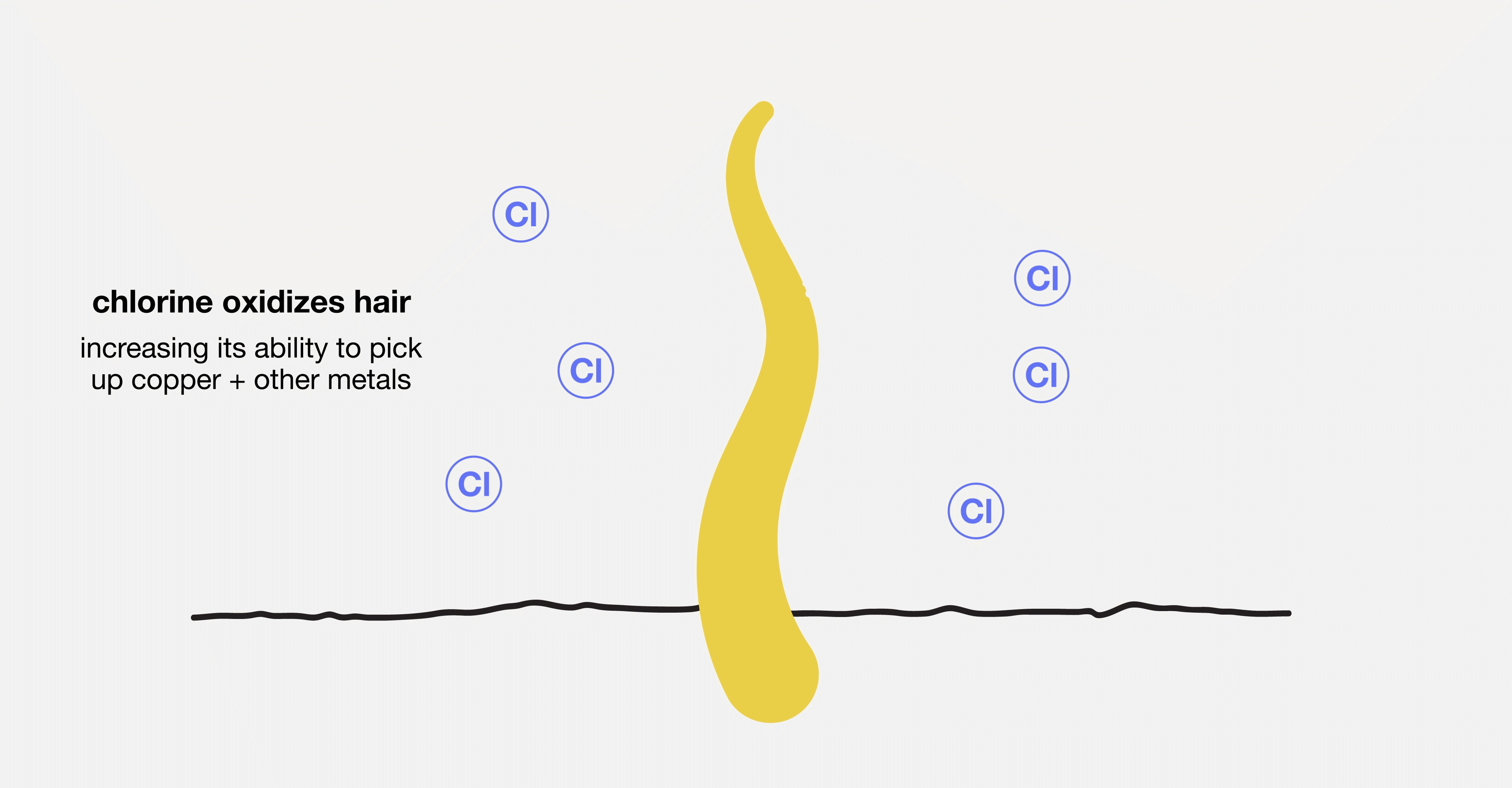You may have seen clients come in with swimmer’s hair—the dry, brittle, and even green aftermath of a pool or beach day. There’s a common myth that this comes from over-exposure to chlorine in water, but the reality is a little more (chemically) complicated. Before we dive into the nitty-gritty, let’s get to the surprising root of swimmer’s hair—your client’s hair health.
swimmer’s hair = damaged hair
Hair fibers are made mainly of proteins, which are organized into two main layers. The first is the outside cuticle layer, made of overlapping scales. Healthy hair has a smooth, intact cuticle that’s covered by a protective barrier of lipids— and helps shield the inner layer of hair, or the cortex. Healthy hair with an undamaged cuticle + cortex feels smooth, strong, less tangled, and so much easier to style.
But, let’s be real—every client has some level of damage + different types of damage can come from multiple places in anyone’s routine. Think mechanical damage from brushing or towel drying, heat damage from hot tools, chemical damage from salon services, and environmental damage from just living with hair.

Damaged hair leads to negative impact on the overall structure. The cuticle scales become more spread out and porous so water can easily flow in and out of hair. What’s in the water (and what’s getting inside hair) can cause some extreme and unwanted reactions during salon services, degrading the cortex and resulting in breakage—more on that later.
the deal with hard water
We’ve talked about hard water before, but in case you need a refresher, hard water is high in dissolved minerals and metals, specifically calcium and magnesium. 85% of the US lives with hard water. But there are other kinds of metals present even in soft water, so chances are, your clients most likely have some level of metal + mineral buildup. With healthy hair, this is less of a concern as its structure is more intact and there are less places for the metals to stick to.
But since many people do have damaged and porous hair, the hair fibers take in water more easily, and more metals + minerals along with it. Over time, this builds up on the hair cuticle and in the cortex (the middle layer of your hair) to cause unwanted chemical reactions leading to discoloration, smoking foils, and even hair disintegration. Yikes.
the real culprit
So, what does all of this have to do with swimmer’s hair? Well, as we said in the beginning, it’s not actually chlorine that changes the color here, but the presence of… copper. Yep, copper is the culprit.
Copper ions can be found in the water from copper-containing algicides (a popular additive to control algae growth in pools), from metal piping, or even from the tap water source used to fill the pool. Certain forms of copper have a bright blue-green color, which, combined with the yellow undertones of bleached or blonde hair, make it appear that not-so-wanted green.
But why doesn’t copper present in normal tap water turn hair green? Contrary to popular belief, swimmer’s green is the result of your hair’s exposure to the combination of chlorine from pools and copper from the water. The chlorine acts as a strong oxidizer, enhancing copper’s absorption by hair. So the more copper, the more green color.
Let’s dive even deeper.

Chlorine from pool disinfectant acts as a strong oxidizer like bleach—degrading hair color, and bringing all the structural damage of a typical lightening service. Even at low concentrations, chlorination of hair results in cysteine rupture and oxidation as well as peptide bond breakage! Swimming outside can worsen this damage—chlorine coupled with UV radiation from the sun causes damage to your hair color + hair proteins.
Repeated exposures have a cumulative effect, so the more times hair is immersed in chlorine water, the more damage will accrue. This impacts other types of damage too. The hair cuticle is softened and lifted which increases friction on the surface of the hair, making it easier to tangle and more prone to mechanical damage from brushing. In severe cases as with competitive swimmers, it can remove the cuticle completely, exposing the underlying cortex.
All in all, this is a vicious cycle of metals damaging hair, creating more places for metals like copper to bind to hair proteins, thus causing more damage. Ultimately, this impairs hair’s elasticity—leaving it duller and more prone to breakage.
how to fix swimmer’s hair
Advise clients to keep their hair healthy by focusing on damage repair with holistic haircare. By keeping hair’s protein structure intact they will prevent damaging metal buildup from wreaking havoc on an already weakened hair structure.
If the damage is already done, they may need your professional expertise for a full reset. Recommend a detox shampoo (ours removes 76% copper) to fight metal + mineral buildup or take it to the next level with a professional demineralizing treatment. This breaks the bonds formed between metals, minerals, and your hair to eliminate copper buildup and tackle swimmer’s hair at the source.
The more you know, right?

